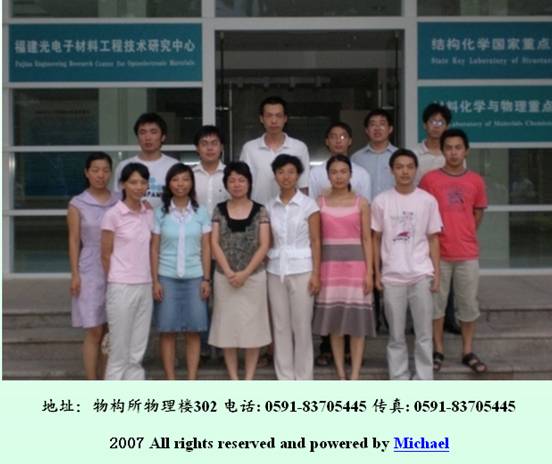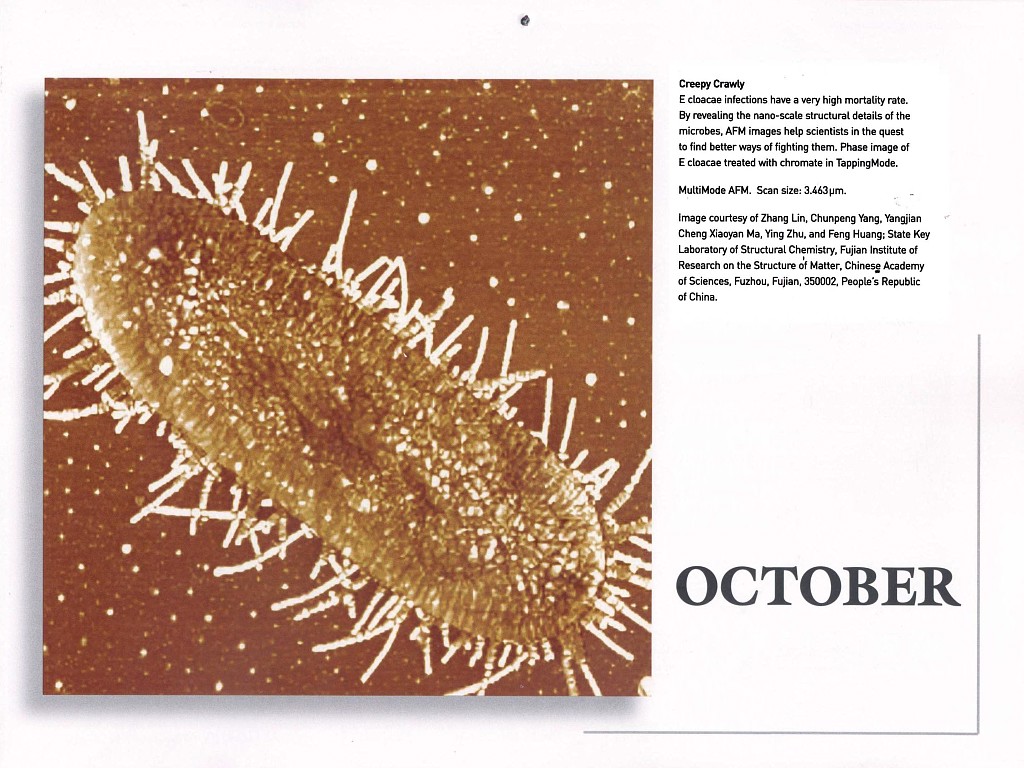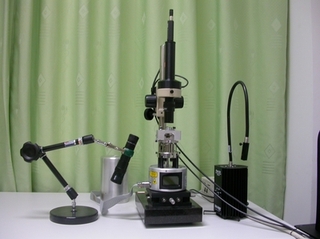|
姓 名:林 璋
性 别: 女
出生日期: 1971年6月
工作单位: 中国科学院福建物质结构研究所,研究员
邮箱:zlin@fjirsm.ac.cn
通讯地址:福建省福州市杨桥西路155号
联系电话:0591-83705445
|
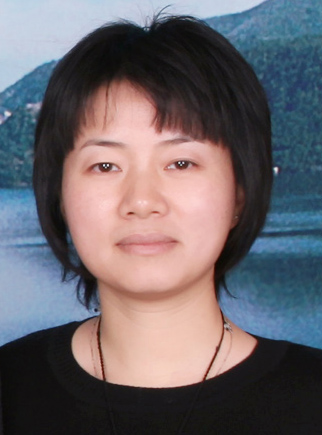 |
学历和工作简历:
主要的研究方向包括:
纳米材料制备的主要困难在于如何对其尺寸和形貌进行控制。纳米晶生长动力学研究对纳米材料的可控性制备具有极其重要的指导意义。纳米晶生长动力学主要是研究纳米粒子在一定环境下的生长机制、生长过程中尺寸和形貌的变化规律、以及生长过程中伴随的相转变等动力学现象。通过对纳米晶微观结构的考察,揭示其生长机制,并在此基础上建立动力学模型来解释和拟合生长过程,从而揭示纳米材料的生长规律。
(1)纳米生长动力学
(2)生物矿化及介观研究方法学
重金属还原细菌和重金属相互作用的分子机制。近来在微生物除铬和铀的介观生物与化学机制研究中,结合长期以来在 结构化学、表面化学、生物与微生物学、各类前沿介观表征技术的积累,
对复杂环境生物学问题提出并初步确立了从三个不同侧面进行基础研究的方法学:
①细菌和重金属相互作用中的结构化学问题
②细菌和重金属相互作用中的介观成像研究方法学
③重金属刺激下的细菌的基因表达差异和蛋白质组学问题
(3)环保应用研究
纳米材料有环境负面效应,如大气中颗粒与各种疾病的发作密切相关,已开始工业使用并遗留在环境中的TiO2纳米颗粒可对人的肺和神经系统产生损伤;工矿企业常产生难处理的重金属纳米废弃物;微生物也可能产生粒度小、可迁移的重金属纳米物质。因此,纳米污染物的去除也成为新的问题。我们认为可以通过有目的的表面界面调控来实现纳米材料的快速生长或相变从而实现对环境纳米物质的处理。
铬渣在露天堆放时,经长期雨水冲淋后大量的六价铬离子随雨水溶浸进入地表,污染地下水和江河、危害水产、农田和各类动植物,进而危害人类。六价铬是国际癌症研究中心公布的三大致癌金属之一,水溶性六价铬被列为对人体危害最大的八种化学物质之一。六价铬毒性比三价铬高100-1000倍,但六价铬是稀缺的重金属资源和战略物质,我国储量不到1%,而生产和使用占全球的30%以上。我们的研究思路是改变纳米材料的粒径并使六价铬自然脱吸附,并将相变处理后的含铬废渣纳米材料回收利用以达到资源的充分利用。
主要科研成果简介:
2004年回国以来,围绕重金属污染问题开展工作,研究了纳米级重金属污染物的生长、相变和脱附规律,揭示了表界面调控在促使纳米晶快速生长、相变、脱吸附中的作用,提出了利用快速生长消除纳米级重金属污染物的新思路,并将其成功用于我国氯酸盐行业典型纳米铬渣污染难题的处理。在污染企业通过吨级中试,实现铬和脱毒渣高附加值回收利用,成果通过省级鉴定,并获福建青年科技奖。针对重金属铬的微生物修复中所发现的“还原容易但固定困难”瓶颈问题,探索了微生物还原和固定铬的介观过程,阐明了微生物表面对铬的配位机制和还原产物的结构和转化规律,提出了通过调控营养源中氨基酸的含量来实现微生物高效固定铬的原理,进一步给出了一类微生物对铬污染治理中的有效固定铬的方法。拓展了原子力显微方法学在微生物-重金属相互作用研究中的应用。相关研究结果以第一作者或通讯作者在国际重要学术刊物上发表,如 Angew. Chem. Int. Ed. (一篇, 2008)、 J. Am. Chem. Soc. (两篇, 2006) 、 J. Phy. Chem. (三篇, 2007&2008)、 Langmuir (两篇,2007&2008) 、Nanotechnology (2007)等。在近五年发表(含已接受)的24篇SCI论文中,IF > 7的有4篇,IF>3的有14篇。论文五年内他引308次,五年内单篇最高它引97次,申请专利6项。从研以来,共发表论文61篇,其中SCI论文46篇。
五年内论著目录(其中前十篇为代表论著,名字标上*号的作者为通讯联系人)
1. Liu, W.Z., Huang, F., Wang, Y.J., Zou, T., Zheng, J.S., Lin, Z.* (2011) Recycling Mg(OH)2 nanoadsorbent during treating the low concentration of CrVI. Environmental Science & Technology, 45(5): 1955-1961.
2. Zhan, Z.B., Zhang, J.Y., Zheng, Q.H., Pan, D.M., Huang, J., Huang, F.*, Lin, Z.* (2011) Strategy for preparing Al-doped ZnO thin film with high mobility and high stability. Crystal Growth & Design 11(1), 21-25.
3. Zhan, Z.B., Wang, Y.H., Lin, Z., Zhang, J.Y.*, Huang, F.* (2011) Study of interface electricfield affecting the photocatalysis of ZnO. Chemical Communications 47, 4517–4519.
4. Gao, S.Y., Wu, Z.X., Pan, D.M., Lin, Z.*, Cao, R.* (2011) Preparation and characterization of polyoxometalate–Ag nanoparticles composite multilayer films. Thin Solid Films, 519(7), 2317-2322.
5. Lin, S*, Pan, D.M., Lin, Q., Yin, S.G., Chen, D.G., Liu, Q.H., Yu, L.L., Lin, Z.* (2011) Evaluation of phase, microstructure and composition of human dentine after Er,Cr:YSGG laser irradiation. Journal of Nanoscience and Nanotechnology 11(4), 2421-2426.
6. Pan, X.H., Chen, Z., Cheng, Y.J., Pan, D.M., Yin, S.G., Huang, F., Guan, X.*, Lin, Z.* (2011) The analysis of the immobilization mechanism of Ni(II) on Bacillus cereus. Journal of Nanoscience and Nanotechnology, 11(4): 3597-3603.
7. Hong, Y.P., Lin, Z., Huang, J., Wang, Y.J.*, Huang, F.* (2011) Study on the influence of lattice integrity and phase composition to the photocatalytic efficiency of ZnS material. Nanoscale, 3, 1512-1515.
8. Lin, W.W., Ding, K., Lin, Z., Zhang, J.Y., Huang, J.K., Huang, F.* (2011) The growth and investigation on Ga-doped ZnO single crystals with high thermal stability and high carrier mobility. Crystengcomm, 13, 3338-3341.
9. Yin, S.G., Huang, F., Zhang, J.*, Zheng, J.S., Lin, Z* (2011) The Effects of Particle Concentration and Surface Charge on the Oriented Attachment Growth Kinetics of CdTe Nanocrystals in H2O. The Journal of Physical Chemistry C, 115, 10357–10364.
10. Zou, T., Wang, Y.J., Lin, Z.* (2011) Synthesis, Crystal Structure and Properties of a Novel Nickel Citrate Ni(H2cit)(phen)(H2O)·3H2O (H4cit=Citrate Acid, phen=1,10-Phenanthroline). Chinese Journal of Structural Chemistry, 30(4): 587-591.
11. Zheng, Q.H., Huang, F.*, Ding, K., Huang, J., Chen, D.G., Zhan, Z.B., Lin, Z. (2011) MgZnO-based metal-semiconductor-metal solar-blind photodetectors on ZnO substrates. Applied Physics Letters, 98(22); doi: 10.1063/1.3596479.
12. Ma, X.Y., Pan, X.H., Cheng, Y.J., Wu, Z.X., Pan, D.M., Chen, Z., Li, B., Lin, Z.*, Guan, X.* (2011) Effect of Different Energy Sources on Ochrobactrum anthropi Bacteria Chromium Reduction. Chinese Journal of Structural Chemistry, 30(6): 819-826.
13. Liu, Z.J., Wang, Y.J., Pan, D.M., Chen, Z., Pan, X.H., Wang, Y.H.*, Lin, Z.* (2011) The Cytotoxicity of NiO Nanoparticle with Borate Capping. Journal of Nanoscience and Nanotechnology, 11(9):10142-10148.
14. Pan, D.M., Zhan, Z.B., Chen, D.G., Wu, Z.C., Pang, A.Y., Wang, Y.H.*, Lin, Z.* (2011) Study on the photocatalytic bactericidal mechanism of nanoscale TiO2 films on Escherichia coli. Journal of Nanoscience and Nanotechnology, 11(9), 7621-7626.
15. 潘丹梅,吴智诚,林璋,原子力显微镜在活体微生物实时动态观测中的应用,现代科学仪器(已录用)
16. 吴智诚,潘丹梅,陈志,林文文,程扬健,林璋*. Application of Magnesium-containing Waste in Preparation of Flame-retardant PVC. (2011) IEEE International Conference on Waste Recycling, Ecology, and Environment. P274-276. Publisher: Institute of Electrical and Electronics Engineers, Inc.
17. W. Z. Liu, et al Z. Lin* “Treatment of CrVI-Containing Mg(OH)2 Nanowaste” Angew. Chem. Int. Ed.47(2008), 5619 –5622.
18. J. Zhang, Z. Lin* et al, “A Multistep Oriented Attachment Kinetics: Coarsening of ZnS Nanoparticle in Concentrated NaOH” J. Am. Chem. Soc.128 (2006) 12981-12987.
19. Z. Lin, et al, “A thermodynamically stable nanophase material”. J. Am. Chem. Soc. 128 (2006) 6126-6131.
20. C. Yang, et al Z Lin*,“Surface-Mediated Chromate-Resistant Mechanism of Enterobacter Cloacae Bacteria Investigated by Atomic Force Microscopy” Langmuir 23 (2007) 4480-4485.
21. B. Li, et al Z. Lin* “Microscopic investigations of the Cr(VI) uptake process by intact Ochrobactrum anthropi “ Langmuir 24(2008), 9630-9635.
22. J. Zhang, et al Z. Lin*, “Oriented Attachment Kinetics for Ligand Capped Nanocrystals: Coarsening of Thiol-PbS Nanoparticles” J. Phys. Chem. B 111 (2007)1449-1454.
23. Y. Wang, et al *,“NaOH concentration effect on the oriented attachment growth kinetics of ZnS”, J. Phys. Chem. B Z Lin111 (2007)5290-5294.
24. Y. S. Xiong, et al Z. Lin* “The growth and phase transformation mechanisms of nanocrystalline CdS in Na2S solution “ J. Phys. Chem. C. 112(2008), 9229–9233
25. G. Q. Ren, *, et al, “Relationship between the coprecipitationmechanism, doping structure and physical properties of Zn1−xCoxS nanocrystallites”. Z LinNanotechnology. 18 (2007) Art. No:035705.
26. Z. Lin*,Y. Zhu, Kalabegishvili TL, et al, Effect of chromate action on morphology of basalt-inhabiting bacteria”, “Materials Science & Engineering C-Biomimetic and Supramolecular Systems. 26 (2006) 610-612.
27. D. S. Li, Z Lin, et al, “The Mass Production of ZnS Nanoarchitecture via Thermodynamic Design” Crystal Growth & Design8(2008) 2324–2328.
28. D. S. Li, et al , “Surface Treatment to Enhance Photocatalytic Activity of ZnS Complex Nanostructure via a Z Lin*Post-synthesis Route” J. Nanosci. Nanotecho.Accepted.
29. G. Q. Ren, , et al, “Evolution of ZnS Nanostructure Morphology under Interfacial Free-Energy Control”Z LinChem. Mater. 20(2008) 2438-2443.
30. B. Gilbert, F. Huang, Z. Lin, et al, “Surface chemistry controls crystallinity of ZnS nanoparticles”. Nano Lett.6 (2006) 605–610.
31. W. Li, Q. Kang, Z. Lin, et al, “Paramagnetic anisotropy of Co-doped ZnO single crystal”. Appl. Phys. Lett.89 (2006) Art. No. 112507.
32. X. Y. Ma, et al Z. Lin* ”Surface Microstructure and Component Changes of Chromium-resistantEnterobacter Cloacae CYS-25 Strain” Chinese. J. Struct. Chem. 27 (2008) 15-20.
33. B. Li, et al Z. Lin* ” Surface changes of Ochrobactrum anthropi in Cr(VI) treatment for 1 hour” Chinese. J. Struct. Chem. 28 (2009) 245-249.
34. L. Xue, Z. Lin et al “Structure and crystal growth of Li2Zn2(MoO4) Chinese. J. Struct. Chem. 26 (2007) 1208-121030.
35.
F. Yan, D. Chen, W. Li, Z. Lin, et al, “The ternary system Na2O – ZnO - WO3: compounds and phase relationships” Journal of Alloys and Compounds 458(2008) 138-143.
36. L. Xue, D. Chen, Z. Lin , et al, “Subsolidus phase relation in the system ZnO–Li2O–MoO3”, Journal of Alloys and Compounds 430 (2007) 67–70.
37. L. Xue, D. Chen, Z. Lin , et al “Subsolidus phase relations in the system K2O–ZnO–AO3”(A=Mo,W)Journal of Alloys and Compounds 458(2008) 144-150.
38. P. W. Lv, F. Huang, W. S. Chu, Z. Lin , et al “Intrinsic magnetism of a series of Co substituted ZnO single crystals J. Phys.: Condens. Matter. 20 (2008) 035206 (6pp).
40. Y. H. Wang, D. G. Chen, W. Li, J. Huang, G. H. Wang, Z. Lin et al ”Studies on the Properties of ZnO Crystal Plane Grown by the Innovated Hydrothermal Method” Chinese. J. Struct. Chem. 27 (2008) 399-403.
41. L. P. Xue, Y. J. Wang, P. W. Lv, D. G. Chen, Z. Lin,et al “Growth, Structures, and Properties of Li2Zn2(MoO4)(3) and Co-doped Li2Zn2(MoO4)(3)” Crystal Growth & Design 9 (2009) 914–920.
42. 栗斌;程扬健;马晓艳;王永好;郑晋生;储旺盛;吴自玉;林璋* “微生物矿化机制研究中的介观分析技术:以微生物与六价铬相互作用为例” 高校地质学报13 (2007) 651-656.
专利:含六价铬废渣的铬分离回收法,林璋,刘炜珍,黄丰,廖逸群,庄赞勇 公开号:CN101209873-A
专利:苍白杆菌CTS-25及其培养方法以及还原六价铬的应用,林璋,马晓艳,程扬健,栗斌,廖逸群,吴兆贤 申请号: 200710009694.5
成果:氯酸盐企业含铬废渣的纳米相变处理和回收利用技术 林璋等,闽科鉴字[2007]第64号
杨春鹏及程扬健等人有关抗铬细菌的原子力显微镜研究结果入选2007年Veeco公司挂历竞赛图片,标志着我组在细菌成像技术上的国际前沿水平。
潘丹梅等于2008年利用AFM在微生物成像研究工作于再获亚太地区美图竞赛奖。

工作人员:
|
(1)程扬健,男,汉族, 1975年10月生
福建松溪人, 2000年7月参加工作
毕业于厦门大学生命科学学院,硕士学历
研究方向:生物化学与分子生物学
感兴趣方面 : 微生物环境修复、基因差异表达、
实时定量荧光定量 PCR
电 话 : 0591-83705474; 13075920902
电子邮箱: yjcheng@fjirsm.ac.cn
|

|
已发表和准备发表的文章:
1,Cheng Yang-Jian, Liang Ji-Xuan, Li Qing-Ge. Construction of RNA-containing Virus-like Nanoparticles Expression Vector with Cysteine Residues on Surface and Fluorescent Decorationc. Acta Genetica Sinica, 2005, 32(8): 874-878.(IF=0.88)
2,Yangjian Cheng, Jianjun Niu, Yongyou Zhang, Qingge Li. Preparation of His-Tagged Armored RNA controls for SARS RT-PCR Detection. J. Clinic. Microbiol., 2006,44(10):3557-3561(IF=3.58)
3,Qiuying Huang, Yangjian cheng, Qiwei Guo, Qingge Li. Construction of Armored RNA packaging Foreign Sequence of Increased Length. Clinic. Chem., 2006,52(7): 1446-1448(IF=7.717)
4,Yiqun Liao, Yangjian Cheng, Qingge Li. Preparation of nitrilotriacetic acid/Co2+-linked, silica/boron-coated magnetite nanoparticles for purification of 6×histidine-tagged proteins. Journal of Chromatography A, 2007 (1143) 65–71(IF=3.096)
5,Yangjian Cheng, Ying Zhu, Xiaoyin Ma, Chunpeng Yang, Feng Huang, Zhang Lin. Identification of a Chromium (VI) Responded Protein and the Chromate Resistance Mechanism of Ochrobactrum anthropi CTS-325. AMB, 2007 (Submitted)(IF=2.58)
6,Chunpeng Yang, Yangjiang Cheng, Xiaoyan Ma, Ying Zhu, GuiJun Shan, Feng Huang, Zhang Lin. Atomic Force Microscopy study on the Morphology of Enterobacter cloacae Induced with Chromium (VI). Langmuir, 2007, 23 (8), 4480 –4485. (IF=3.705, 并列第一作者)
获奖情况及证书:
“厦门市科技进步二等奖”一项: SARS 病毒荧光 PCR 核酸检测试剂盒的研制( 2005)
国家新药“二类”证书两项:
1. 结核分支杆菌核酸扩增( PCR ) 荧光检测试剂盒( 2001)
2. 沙眼衣原体核酸扩增( PCR ) 荧光检测试剂盒( 2002)
|
(2)王永静,女,汉族
1979 年6月生,江苏南京人
2008 年3月参加工作
毕业于中科院福建物质结构研究所,博士学历
研究方向:金属硫化物纳米粒子
生长热力学及动力学研究
电话 :0591-83705474; 15080023079
电子邮箱: yongjing_wang@fjirsm.ac.cn
|
 |
已发表的文章:
1. Xue LP, Wang YJ, , Lv PW, Chen DG*, Lin Z, Liang JK, Huang F* and Xie Z,“Growth, Structures, and Properties of Li2Zn2(MoO4)3 and Co-doped Li2Zn2(MoO4)”, Crystal Growth & Design, 2009, 9(2), 914-920
2. Wang YJ, Xu, L*, “pH-dependent displacement of [Bi(citrate)]- with cysteine: Synthesis, spectroscopic and X-ray crystallographic characterization of Bi(cysteine)3”, Journal of Inorganic Biochemistry 2008, 102, 988–991
3. Wang YJ, Xu, L*, “Synthesis and optical properties of two novel chlorobismuthate(III) complexes: [8-Hydroxyquinolinium]4K2[BiCl6]2·6H2O (1) and [8-hydroxyquinolinium]6[Bi2Cl10][BiCl5(H2O)]·6H2O(2)” Journal of Molecular Structure 2008, 875, 570–576
4. Wang YJ, Xu, L*, “Synthesis and Crystal Structure of Bi(Hsal)3(1,10-phenanthroline) (Hsal = O2CC6H4-2-OH)” Chinese J. Struct. Chem. 2008, 27(3), 297~300
5. Wang YJ,Zhao J, Dang ZH, Xu L, “Bis(μ-2-hydroxybenzoato-κ2O:O’)-bis[(2,2’- bipyridine -κ2N,N’)bis(2-hydroxybenzoato-κ2O,O’)bismuth(III)]”, Acta Cryst. Section E, 2007, E63, M1770
6. Wang YJ, Zhang HH, Huang CC, Chen YP, Sun QZ, “Spectral study of two Bi(III) contained heteropolymate compounds”, Spectrosc. Spect. Anal. 2006, 26, 287
7. Wang YJ, Zhang HH, Huang CC, Yu XH, Sun QZ , Sun RQ “Synthesis and characteristics of a new molybdoantimonate KSbMoO5” Chinese J. Struct. Chem. 2005, 24(6), 651
8. Wang YJ, Zhang HH, Sun RQ, Huang CC, Yu XH, “Synthesis and characteristics of a new three-dimensional molybdoantimonate Na4Sb12Mo5O35” J. Solid. State. Chem. 2005, 178, 902
9. Wang YJ, Zhang HH, Huang CC, Yu XH, Sun QZ , Sun RQ, “Synthesis and crystal structure of the heteropolymate compound Na3H2[Ce3(H2O)18Bi2W22O76]·23H2O” Chinese J. Struct. Chem. 2004, 23, 902
10. Wang YJ, Zhang HH, Huang CC, Sun QZ, Yu XH, “Synthesis, structure and spectral properties of a novel molybdoantimonate NaSbMoO5”, Inorg. Chem. Comm. 2004, 7, 21
|
(3)潘丹梅,女,汉族,福建福州人
2007年硕士毕业于厦门大学化学系
2007年8月参加工作
现在测试中心负责扫描探针显微镜的测试与管理工作
E-mail: dmpan@fjirsm.ac.cn
|
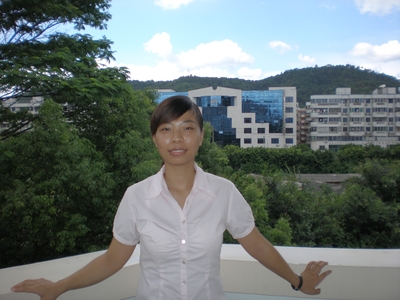 |
学生:
|
(1) 李冬松,男,04级博士生,
本科毕业于辽宁大学化学系
现主要从事纳米材料的研究
Email: dsli@fjirsm.ac.cn
|
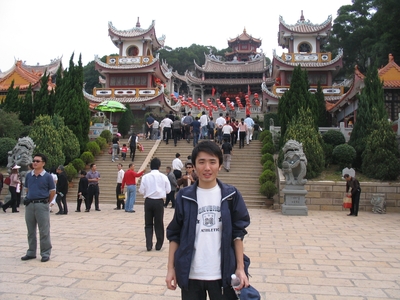 |
|
(2)刘炜珍,女,05级研究生,
本科毕业于中国地质大学(武汉)
材料科学与工程专业
现主要从事铬污染处理技术的工程化实验
及以环境保护为主导的纳米科学问题研究。
Email: wzhliu@fjirsm.ac.cn
发表的论文:W. Z. Liu, et al Z. Lin* “Treatment of CrVI-Containing Mg(OH)2 Nanowaste”
Angew. Chem. Int. Ed. 47(2008), 5619 –5622.
|
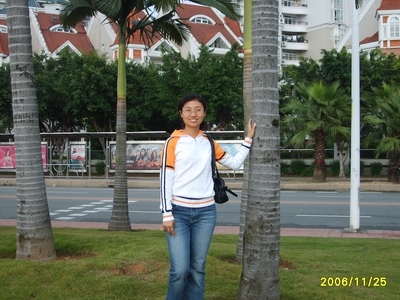 |
|
(3)庄赞勇,男,汉族,福建泉州人
06级硕士生,本科毕业于厦门大学化学系
曾发表的文章:
朱尔一*,林燕,庄赞勇.偏最小二乘变量筛选法在
毒品来源分析中的应用.Chinese J.Anal.Chem(分析
化学),2007,35(7):973-977
|
|
|
(4)陈志,男,福建莆田人,
本科毕业于福建农林大学,现属联合培养学生
主要从事微生物和分子生物学方面的研究
已发表的文章:
黄天培, 潘洁茹, 黄张敏, 陈志, 庄浩瀚, 李今煜, 关雄. 苏云金芽胞杆菌WB9菌株cry2Ac4基因的克隆及表达. 农业生物技术学报,2008,16(2):341-345
|
|
三,主要仪器介绍
SPM是一种利用探针与样品的不同相互作用来探测表面或界面在纳米尺度上表现出的物理性质和化学性质的新型表面分析仪器, 与其它表面分析技术相比,SPM所具有的独特优点:1、原子级高分辨率。2、可实时地得到实空间中表面的三维图像,可用于具有周期性或不具备周期性的表面结构研究。这种可实时观测的性能可用于表面动态化学反应过程的研究。3、可在真空、大气、常温等不同环境下工作,甚至可将样品浸在水和其它溶液中,不需要特别的制样技术,并且探测过程对样品无损伤。这些特点适用于研究生物样品和在不同试验条件下对样品表面的评价。4、利用SPM对固体表面上原子进行操作和移植的纳米加工,对高密度信息存储、纳米电子器件、量子阱器件、新型材料的组成和物种再造等方面将会产生非常重要的影响。
我所引进的SPM是NS3A-02 NanoscopeIIIa Scanning Probe Microscopy 型的,由美国Veeco公司研制生产的。 本实验室配备有原子力显微镜(AFM)模式、磁力显微镜(MFM)模式等。
AFM在环境微生物学上的拓展应用研究:由于细菌表面包裹着大量柔性有机物,使用AFM探测微生物的表面结构和介观过程一直是一个挑战性的课题。目前少有工作能提供较为理想的高分辨率成像从而进行系统性的研究。2004年以来,申请人在前期生物样品的AFM成像技术积累的基础上,克服了一系列技术难点,成功获得了在重金属铬刺激下微生物表面微结构的变化信息,达到前所未有的细节分辨。将AFM手段拓展到微生物的表界面过程的研究。在SPM 全球年度技术竞赛中,被主办方基于科学首创性及前沿性原则从全球200多家AFM研究小组中选出,成为2007年挂历图片,2008年,申请人所领导的团队的微生物成像研究工作于再获亚太地区美图竞赛奖。
 中科院福建物质结构研究所
中科院福建物质结构研究所
